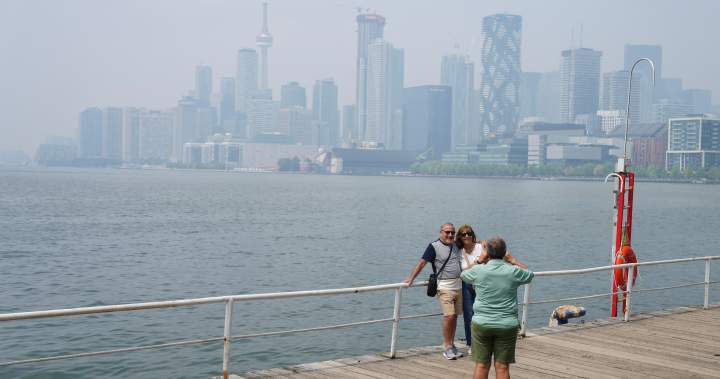If you looked up at the sky this week and saw a grey, drab haze, you are not alone. Large parts of Canada saw air quality dip as wildfire smoke from the Prairies made its way to central Canada.
But experts say forecasting wildfire smoke can be quite challenging.
For starters, predicting wildfire smoke is linked to predicting the weather, which is already a tall task, said University of Montreal chemistry professor Patrick Hayes.
“You need to have good observations, and then those observations are then used in a computer simulation with essentially fundamental physical equations to predict the weather,” he said.

“But if the observations aren’t complete, you don’t have a complete picture, so then it’s hard to predict weather. And if we can’t predict the weather, it’s also hard to also predict where smoke is coming from,” he said.
Predicting smoke from wildfires, as opposed to standard pollution from human activity, is a lot more complicated, said UCLA professor Pablo Saide.
“Smoke prediction is a lot harder than, let’s say, regular anthropogenic pollution prediction because of many different reasons,” Saide said.
“It depends on so many factors on (such as) how severely the fire is burning. Is it burning only kind of (on the) surface? Is it burning the whole canopy? And how deep into the soil is it burning?”
All these factors, he said, are hard to ascertain, making it difficult to predict the direction of the smoke.
The impact a fire has on air quality can depend on several very fickle factors, such as what kind of fuel was burning in the fire.

Get daily National news
Get the day’s top news, political, economic, and current affairs headlines, delivered to your inbox once a day.
“Was it a grass fire? Was it a forest fire? We also need know the burning conditions,” he said.
For example, a fire in a boreal forest may emit a lot of black carbon while an urban fire could be “more problematic” since the emissions could include toxic materials such as arsenic, he said.
Hayes added, “Another complication is we need to know how high the smoke initially rises in the atmosphere.”
The plume height could also determine the nature of the wildfire smoke. For example, Hayes said, some fires burn quite low while others can see the plumes rise 10 km into the air.
Saide added, “When you think about anthropogenic pollution — (from) the cars and pollution coming from houses — that’s emitted at the surface level. But (wildfire) smoke, it can be emitted at surface level and can (also) be emitted all the way up to the stratosphere. There’s events that are almost like volcanoes in terms of wildfire injection,” he said.
To be effective, prediction models would need to figure out exactly where that smoke is being emitted and being transported by the winds, that are different at different levels in the atmosphere, he said.
“If you put all of these uncertainties together and then you add the fact that you’re predicting for a region that it’s like thousands of kilometres away from the source, that adds another level of uncertainty,” he said.
Another complication for prediction models is what stage the source fire is at. Is it a flaming fire or a smouldering fire?
“Smouldering is kind of this white-ish smoke that you see when a fire is kind like dying down. That smouldering phase actually is the one that generates the largest amounts of particulate matter,” Saide said.
Determining when a fire will go from raging to smouldering can be tricky to predict.

With climate change making wildfires more likely, Hayes said Canadians should expect more smoke events in the years to come.
And while predictions can be difficult, it can help to check air quality warnings.
“Go to your local government websites and look at if there’s an air quality warning or not. Environment Canada, for example, publishes an air quality warning. That’s really your best bet for knowing what to do if there is smoke impacting your air quality or not,” he said.
He said the long-term solution is for governments to cut down greenhouse gas emissions. But in the short term, citizens, too, can take certain steps.
“If there’s a high level of fire danger that’s been communicated by the local authorities, you need to not have campfires. Don’t drive your all-terrain vehicle in the forest. Pay attention to what the local authorities are saying about the fire risk and if the risk is high, don’t do these activities that we know can cause fires,” he said.
According to Health Canada, poor air quality can impact respiratory health particularly for seniors, infants, and people with pre-existing heart or lung conditions. Experts recommend reducing outdoor activity when an air quality warning is in effect.
“Stay inside your house, close the windows. You can use an air filtration system,” Hayes said.
If you have to be outdoors, Hayes says an N95 mask can help.
“I know people are kind of tired of wearing masks from COVID-19, but it’s also useful to wear an N95 mask (during a smoke event),” he said.
–with files from Global’s Ross Hull
© 2025 Global News, a division of Corus Entertainment Inc.
Why is it so challenging to forecast wildfire smoke? Unravelling the haze





